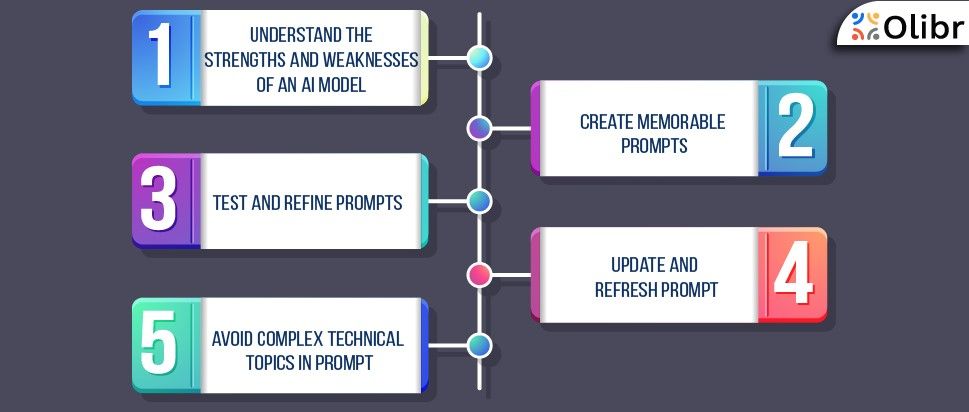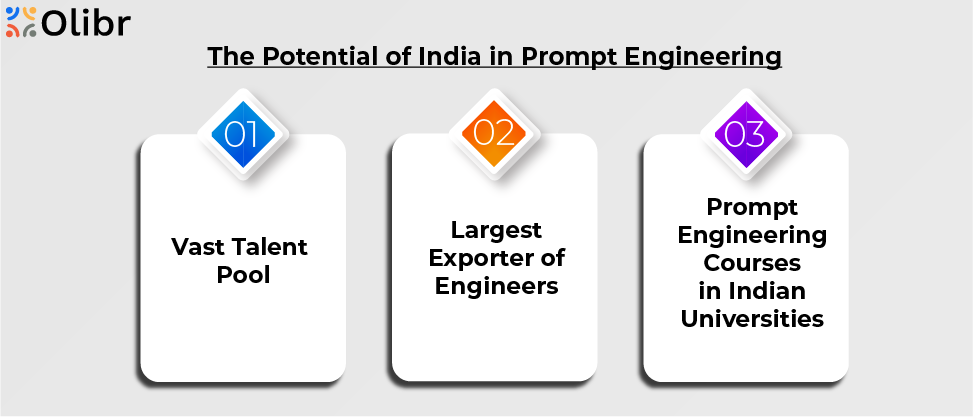Table of Contents
ToggleIntroduction
The demand for prompt engineering is estimated to grow by over 20% annually in 2024. And India is expected to take the lead with the 3.1 million engineers contributing to the field. Since Artificial intelligence (AI) is becoming more advanced and many industries are adopting it, there is a high demand for specialized prompt engineers in natural language processing. In this article, we will explore the rise of prompt engineering in India.
Is Prompt Engineering an Emerging Field in 2024?
The demand for prompt engineers has grown exponentially since organizations recognized that a well-optimized prompt is the key to deploying AI across various fields. Prompt engineers play a key role in solving real-world problems by leveraging natural language processing and crafting effective prompts to extract valuable outputs from artificial intelligence. In simple words, a prompt is nothing but a text input that a user provides to the Gen AI model ChatGPT 3 to get the desired output. A prompt can be in any form: audio, image, or text. To get the most out of AI models, a prompt engineer needs to understand AI’s strengths and limitations and then leverage the nuances of language, emotion, logic, and human psychology to guide AI. This way, they can craft a prompt through which AI can provide relevant and correct output. Prompt engineering is not only highly sought after by tech firms but also by other industries like consultancies, publishers, healthcare, and financial institutions.
Importance of Prompt Engineering for Large Language Models (LLMs)
LLM is an AI algorithm that uses deep learning. It is built upon neural networks and trained on a massive amount of data. Due to this, it can easily understand the complex relationships within the language and generate new content. Given the correct instructions, this LLM can function as a vertical computer. Nevertheless, the success and high performance of these models depend on effective prompts written by humans. Therefore, prompt engineers play a crucial role in leveraging the potential of LLM to the fullest. With the right prompt, not only does the performance of LLM become better, but it also provides the structure of prompts for different domains. This, in turn, saves a lot of time and resources.
Techniques for Optimizing Prompt
You must combine creativity, intuition, and data-driven approaches to fully optimize the prompt for the generative AI model ChatGPT. The following techniques can help you create effective and engaging prompts that help you get desirable output:

- Understand the Strengths and Weaknesses of an AI Model: First, try to understand the capabilities and limitations of the language model, then write a clear and concise text so that the model generates more relevant responses.
- Test and Refine Prompts: Create prompts that reflect the interests and motivations of your audience. Also, experiment with different formats and styles to see what works best and get feedback from users. To make your prompts better, consider using data-driven approaches to refine and optimize your prompts.
- Avoid Complex Technical Topics in Prompt: Make sure that the prompt is related to the topic. Don’t use jargon and complex language; try incorporating examples and analogies to help explain complex concepts. If your topic is complex, then break it into smaller chunks, including humor and creativity, and make a story.
- Create Memorable Prompts: Write clear and concise instructions using visuals, diagrams, and additional resources to support the prompts. Try adding a conversion tone, as this encourages user interaction and engagement with your prompts.
- Update and Refresh Prompt: For every individual user, create a personalization prompt. Keep it relevant and continuously monitor the performance of the programs. ChatGPT is still in the early stages and keeps evolving. Thus, it is important to note that optimizing prompts for language models like ChatGPT needs continuous monitoring and updating, as this ensures the prompt is effective and relevant. Another way to make your prompts effective is by collecting feedback on how users interact with them and analyzing the responses generated by the language model.
India's Potential in Prompt Engineering in 2024

Vast Talent Pool: There is no shortage of talent in India; over 1.5 million engineers graduate annually from more than 4000 engineering colleges. This number speaks volumes and shows the potential of the nation for the development of advanced fields like prompt engineering. Most Indian engineering colleges include the curricula of prompt engineering to stay updated with these changing trends. Likewise, many institutions started to offer specialized courses in AI, machine learning, and data science. Not to mention that India comes in second in the world among the numerous students enrolled in Coursera AI courses. This shows the zeal and eagerness of Indian engineers to learn and adapt to the new technological trend, foreshadowing a promising career in prompt engineering.
Largest Exporter of Engineers: India is a global supplier of engineers. The country’s vast talent pool and premier institutions, like the Indian Institutes of Technology (IITs) and the National Institutes of Technology (NITs), have introduced specialized courses in AI, machine learning, and data science, which can create a strong foundation for prompt learning. On top of that, the Indian government’s adoption of AI has led to an increase in AI-related initiatives. According to the National Strategy for Artificial Intelligence by the Government of India, it aims to take the lead as a global leader in AI. This will boost development as well as specialized fields like prompt engineering.
Prompt Engineering Courses in Indian Universities: India’s initiative to include prompt engineering in the university curriculum shows the big steps to building a strong AI ecosystem. Also, the Indian principal regulatory body for technical education, i.e., the All India Council for Technical Education (AICTE), has recognized the importance of AI and related fields. Due to this, the Indian Institute of Technology (IIT) Madras launched an online degree program in data science and machine learning; these are the building blocks of prompt engineering. Likewise, other premier institutions, like IIT Hyderabad and IIT Delhi, have also introduced AI-specific programs. These initiatives can significantly help students with the fundamentals and necessary skills to get into fields like prompt engineering. But this course is not only for universities but is also introduced in schools too. This will increase research in AI scope at the university later and contribute to the country’s prompt engineering development.

Don't miss out on your chance to work with the best
apply for top global job opportunities today!
How does the Job Market for Prompt Engineers look like in India?
AI is making a storm lately, making it an indispensable tool in every business. These prompt engineers, with their effective and optimized prompts to enhance the performance of AI models, are increasingly sought after in the job market. Thus, the demand for prompt engineers will reach its peak in the coming years. However, according to the Glassdoor report, AI specialists and prompt engineers are among the highest-paying prompt engineering jobs in tech firms. As your skills get more specialized, the salary for prompt engineers will be competitive and lucrative. However, prompt engineering salary trends can vary based on factors, including their level of experience and expertise, the tasks they are working on, the industry in which they work, and their geographical location. Let’s say that prompt engineers who work in finance or healthcare can earn a higher salary because, in this field, AI decisions can have serious consequences.
| Job Role | Salary |
|---|---|
| Prompt Engineer intern | $10,005 per year |
| Artificial Engineer Prompt Engineer | $4,15,968 per year |
| AI Engineer | $23, 22019 per year |
| ML Engineer | $14, 50472 per year |
Source: Glassdoor
Is the Future Promising for Prompt Engineers in 2024?
According to the current scenario, prompt engineers are in a favorable position. With the rise of AI adoption across sectors and the increasing complexity of AI applications, prompt engineering is expected to grow. In the coming years, it will be one of the most important skills to unleash the full potential of AI models. As businesses continue to invest in AI technologies and applications, the need for prompt engineers is set to rise. The job of a prompt engineer is not replaceable by automation. Although AI can automate many tasks, optimizing prompts and crafting them requires a deep understanding. Therefore, it needs skilled prompt engineers to understand AI technologies and language nuances, which are beyond the capabilities of AI. In the context of prompt engineering, India has immense potential to become a global leader. In the past, India missed out on technological growth in hardware and software. However, with the strong emphasis on adopting AI in various sectors and the Indian government recognizing the importance of AI-focused courses in education, research, industry, and policy can help India rise again and gain a competitive edge globally.
Take control of your career and land your dream job
sign up with us now and start applying for the best opportunities!

FAQs
Prompt engineering is the art of writing and optimizing prompts for generative AI models like GPT to extract the most value from these models and tailor the outputs to their specific needs.
The common uses of prompt engineering are text generation, translation, summarization, question answering, language understanding, sentiment analysis, grammar correction, data extraction, text classification, and code generation.
You can learn prompt engineering to fully optimize generative AI, prevent ethical considerations, and get a competitive advantage in business.
There are five core principles for those: role-playing, context information for correct and relevant output, format, style, and setting the tone of desired output; prompts changing from progressive-to-progressive refinement; feedback rating scores for improved output; and providing complex instruction with examples.

